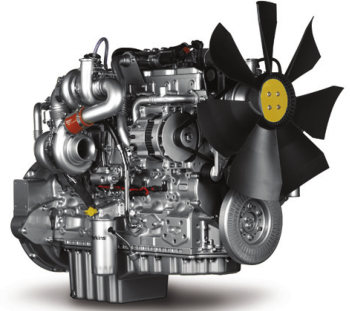详细描述
Specifications
1206F-E70TA and 1206F-E70TTA
Industrial Engines
BM (Engine)
BN (Engine)
This document is printed from SPI². Not for RESALE
![]()
![]()
![]()
![]()

Important Safety Information
Most accidents tha t involve produc t op eration, ma intena nc e and repair are caus ed by failure to
ob serve basic safety rules or precautions . An accident can often be avoided by recog nizing pote ntially
ha za rdous situations before an accident oc curs . A person mus t be alert to pote ntial ha za rds. This
person should also ha ve the ne cessary training, skills and tools to perform the se func tions properly.
Improper operation, lubrication, maintenance or repair of this product can be dangerous and
could result in injury or death.
Do not operate or perform any lubrication, maintenance or repair on this product, until you have
read and understood the operation, lubrication, maintenance and repair information.
Sa fety precautions and warning s are provided in this ma nua l and on the produc t. If the se ha za rd
warning s are not he eded, bod ily injury or death could oc cur to you or to othe r persons .
The ha za rds are identified by the “Safety Alert Symb ol” and followed by a “Signa l Word” suc h as
“DANGER”, “WARNING” or “CAUTION”. The Sa fety Alert “WARNING” label is shown below.
The me aning of this safety alert symb ol is as follows:
Attention! Become Alert! Your Safety is Involved.
The me ssage tha t appears und er the warning explains the ha za rd and can be either written or
pictorially presente d.
Op erations tha t ma y caus e produc t dama ge are identified by “NOTICE” labels on the produc t and in
this pub lication.
Perkins cannot anticipate every possible circumstance that might involve a potential hazard. The
warnings in this publication and on the product are, therefore, not all inclusive. If a tool, procedure,
work method or operating technique that is not specifically recommended by Perkins is used,
you must satisfy yourself that it is safe for you and for others. You should also ensure that the
product will not be damaged or be made unsafe by the operation, lubrication, maintenance or
repair procedures that you choose.
The informa tion, specifications , and illustrations in this pub lication are on the basis of informa tion tha t
was available at the time tha t the pub lication was written. The specifications , torque s, pressure s,
me asure me nts , adjustme nts , illustrations , and othe r items can cha ng e at any time. These cha ng es can
affect the service tha t is given to the produc t. Ob tain the comp lete and mos t current informa tion before
you start any job. Pe rkins dealers or Pe rkins distributors ha ve the mos t current informa tion available.
When replacement parts are required for this
product Perkins recommends using Perkins
replacement parts.
Failure to heed this warning can lead to prema-
ture failures, product damage, personal injury or
death.
This document is printed from SPI². Not for RESALE
![]()
![]()
UENR0675
3
Table of Contents
Table of Contents
Accessory Drive....................... ....................... 42
Front Housing and Covers............... ............... 42
Gear Group (Front)..................... .................... 43
Flywheel .......................................................... 44
Flywheel Housing...................... ..................... 44
Belt Tensioner......................... ........................ 45
Refrigerant Compressor................. ................ 45
Fan Drive............................ ............................ 46
Engine Lifting Bracket................... .................. 46
Alternator............................ ............................ 46
Starter Motor.......................... ......................... 48
Nitrogen Oxide Sensor .................. ................. 50
Coolant Temperature Sensor............. ............. 51
Engine Oil Pressure Sensor.............. ............. 51
Boost Pressure Sensor.................. ................. 51
Atmospheric Pressure Sensor............ ............ 52
Inlet Manifold Temperature Sensor......... ........ 52
Turbocharger Exhaust Temperature Sensor . . 53
Temperature Sensor (DPF Inlet)........... .......... 53
Temperature Sensor (Exhaust)............ ........... 54
Pressure Sensor (NOx Reduction System).. .. 54
Temperature Sensor (NOx Reduction System)55
Soot Antenna......................... ......................... 55
Speed/Timing Sensor................... .................. 56
Electronic Control Module ............... ............... 56
Electronic Control (Diesel Exhaust Fluid).... ... 57
Glow Plugs .......................... ........................... 57
Air Compressor (Twin Cylinder Compressor) 58
Air Compressor (Single Cylinder)......... ......... 59
SpecificationsSection
Engine Design ......................... ......................... 4
Fuel Injection Lines...................... ..................... 4
Fuel Injection Pump..................... ..................... 5
Fuel Injectors.......................... .......................... 6
Fuel Transfer Pump (Electric Transfer Pump) . 6
Fuel Filter Base (Single Secondary Fuel Filter
Base) ............................... ............................... 7
Fuel Filter Base (Twin Secondary Fuel Filter
Base) ............................... ............................... 7
Fuel Filter Base (Primary Fuel Filter Base)... ... 8
Fuel Manifold (Rail)...................... ..................... 9
Lifter Group............................ ........................... 9
Rocker Shaft........................... .......................... 9
Valve Mechanism Cover................. .................11
Cylinder Head Valves ................... ...................11
Cylinder Head......................... ........................ 12
Turbocharger (Series Turbochargers)...... ...... 14
Turbocharger (Single Turbocharger)....... ....... 17
Injector (Diesel Exhaust Fluid)............ ............ 18
Manifold (Diesel Exhaust Fluid)........... ........... 20
Diesel Exhaust Fluid Tank ............... ............... 20
Diesel Exhaust Fluid Pump .............. .............. 21
Exhaust Gas Valve (NRS) ............... ............... 21
Exhaust Cooler (NRS).................. .................. 23
Exhaust Manifold...................... ...................... 25
Flexible Exhaust Pipe................... .................. 26
Camshaft............................ ............................ 26
Camshaft Bearings..................... .................... 27
Engine Oil Filter Base................... .................. 28
Engine Oil Cooler...................... ...................... 28
Engine Oil Pump....................... ...................... 29
Engine Oil Pressure.................... .................... 30
Engine Oil Pan........................ ........................ 31
Crankcase Breather.................... .................... 33
Water Temperature Regulator and Housing.. . 34
Water Pump.......................... .......................... 34
Cylinder Block......................... ........................ 35
Crankshaft........................... ........................... 35
Crankshaft Seals ...................... ...................... 36
Vibration Damper and Pulley............. ............. 37
Connecting Rod Bearing Journal.......... .......... 37
Main Bearing Journal................... ................... 38
Connecting Rod....................... ....................... 38
Piston and Rings ...................... ...................... 39
Piston Cooling Jet...................... ..................... 40
Accessory Drive (SAE “B” ).............. ............. 41
Index Section
Index................................ ............................... 61
This document is printed from SPI². Not for RESALE
![]()
4
UENR0675
Specifications Section
SpecificationsSection
i04928625
Fuel Injection Lines
i03519906
Engine Design
Contact with high pressure fuel may cause fluid
penetration and burn hazards. High pressure fuel
spray may cause a fire hazard. Failure to follow
these inspection, maintenance and service in-
structions may cause personal injury or death.
Refer to Operation and Maintenance Manual,
“General Hazard Information and High Pressure Fuel
Lines” before adjustments and repairs are performed.
NOTICE
Refer to Systems Operation, Testing and Adjust-
ing, “Cleanliness of Fuel System Components”
for detailed information on the standards of clean-
liness that must be observed during ALL work on
the fuel system.
Illustration 1
g01284058
Cylinder and valve location
(A) Exhaust valve
(B) Inlet valve
Ensure that all adjustments and repairs are
performed by authorized personnel that have had the
correct training.
Bore ............................................105 mm (4.133 inch)
Stroke .........................................135 mm (5.315 inch)
Displacement......................7.01 L (427.78 cubic inch)
Cylinder arrangement ........................................In-line
Type of combustion ..............................Direct injection
Compression ratio
Turbocharged charge cooled ....................16.5:1
Number of cylinders .................................................. 6
Valves per cylinder .................................................... 4
Firing order .............................................1, 5, 3, 6, 2, 4
When the crankshaft is viewed from the front of the
engine, the crankshaft rotates in the following
direction: .....................................................Clockwise
When the camshaft is viewed from the front of the
engine, the camshaft rotates in the following direction:
.....................................................................Clockwise
The front of the engine is opposite the flywheel end.
The left side and the right side of the engine are
viewed from the flywheel end. The No. 1 cylinder is
the front cylinder.
This document is printed from SPI². Not for RESALE
![]()
![]()
![]()
![]()
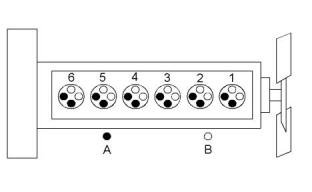
![]()
![]()
![]()
UENR0675
5
Specifications Section
Illustration 2
g02293673
Typical example
(1) (2) Tighten the nuts on the high-pressure fuel lines
to the following torque.........................55 N·m (41 lb ft)
i04085749
Fuel Injection Pump
Note: The timing of the fuel injection pump will need
to be checked by trained personnel. In order to check
the timing of the fuel injection pump, refer to Systems
Operation, Testing and Adjusting, “Fuel Injection
Pump Timing - Check”.
NOTICE
Refer to Systems Operation, Testing and Adjust-
ing, “Cleanliness of Fuel System Components”
for detailed information on the standards of clean-
liness that must be observed during ALL work on
the fuel system.
Illustration 3
g02293713
Typical example
(1) Tighten the studs to the following torque.....11 N·m
(97 lb in)
(2) Tighten the mounting nut to the following torque.
............................................................22 N·m (16 lb ft)
This document is printed from SPI². Not for RESALE
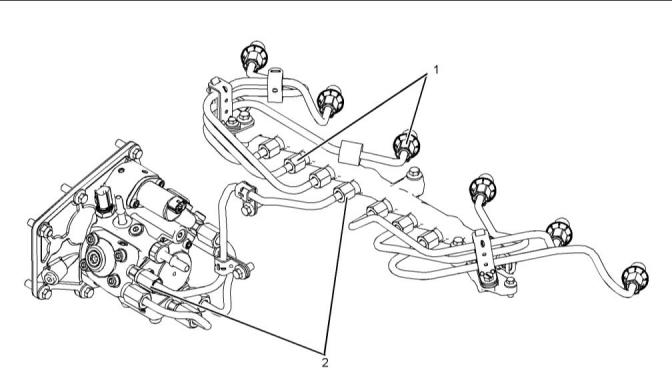
![]()
![]()
![]()
![]()
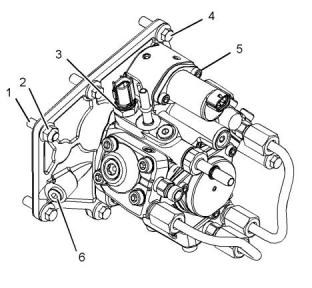
![]()
![]()
6
UENR0675
Specifications Section
(3) Tighten the fuel temperature sensor to the
(2) Torque for the bolt in the clamp for the fuel
following torque...................................22 N·m (16 lb ft)
injection nozzle................................21 N·m (15.5 lb ft)
(4) Tighten the setscrews to the following torque.
............................................................22 N·m (16 lb ft)
i05449450
Fuel Transfer Pump
(Electric Transfer Pump)
(5) Tighten the screws for the suction control valve to
the following torque..............................9 N·m (80 lb in)
(6) Tighten the screw to the following torque.
............................................................14 N·m (10 lb ft)
i03631793
Fuel Injectors
NOTICE
Refer to Systems Operation, Testing and Adjust-
ing, “Cleanliness of Fuel System Components”
for detailed information on the standards of clean-
liness that must be observed during ALL work on
the fuel system.
Illustration 5
g02291814
Typical example
(1) Tighten the connection to the following torque.
............................................................20 N·m (15 lb ft)
Illustration 4
g01862457
Typical example
(3) Clamp
(4) Washer
(5) O ring seal
Illustration 6
g02291815
(1) Torque for the nuts..........................2 N·m (18 lb in)
Typical example
This document is printed from SPI². Not for RESALE
![]()
![]()
![]()
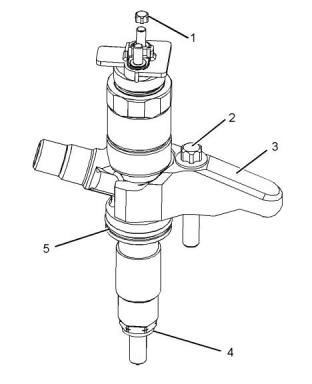
![]()
![]()

![]()
![]()

![]()
![]()
UENR0675
7
Specifications Section
(2) (3) Tighten the bolts to the following torque.
............................................................22 N·m (16 lb ft)
i05365831
Fuel Filter Base
(Single Secondary Fuel Filter
Base)
NOTICE
Refer to Systems Operation, Testing and Adjust-
ing, “Cleanliness of Fuel System Components”
for detailed information on the standards of clean-
liness that must be observed during ALL work on
the fuel system.
Illustration 8
g03396250
If necessary, install a new fuel filter (2) to canister (1).
Refer to Operation and Maintenance Manual, “Fuel
System Secondary Filter - Replace” for the correct
procedure.
Typical example
(5) Tighten the screw to the following torque.
..........................................................2.5 N·m (22 lb in)
i05371617
Fuel Filter Base
(Twin Secondary Fuel Filter
Base)
NOTICE
Refer to Systems Operation, Testing and Adjust-
ing, “Cleanliness of Fuel System Components”
for detailed information on the standards of clean-
liness that must be observed during ALL work on
the fuel system.
If necessary, install a new fuel filter (2) to canister (1).
Refer to Operation and Maintenance Manual, “Fuel
System Secondary Filter - Replace” for the correct
procedure.
Illustration 7
g02516539
Typical example
(3) Tighten the bolts to the following torque......44 N·m
(33 lb ft)
(4) Tighten the bolt to the following torque. ......17 N·m
(13 lb ft)
This document is printed from SPI². Not for RESALE
![]()
![]()
![]()
![]()
![]()

![]()
![]()
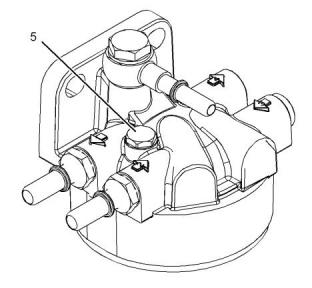
![]()
![]()
8
UENR0675
Specifications Section
i04916708
Fuel Filter Base
(Primary Fuel Filter Base)
NOTICE
Refer to Systems Operation, Testing and Adjust-
ing, “Cleanliness of Fuel System Components”
for detailed information on the standards of clean-
liness that must be observed during ALL work on
the fuel system.
If necessary, install a new fuel filter element to
canister (2). Refer to Operation and Maintenance
Manual, “Fuel System Primary Filter (Water
Separator) Element - Replace” for the correct
procedure.
Illustration 9
g02518537
Typical example
(3) Tighten the bolts to the following torque......44 N·m
(33 lb ft)
(4) Tighten the bolt to the following torque. ......17 N·m
(13 lb ft)
Illustration 11
g03084516
Typical example
Tighten water in fuel switch (1) hand tight.
(3) Tighten the connection to the following torque.
............................................................17 N·m (13 lb ft)
(4) Tighten the bolts to the following torque......44 N·m
(32 lb ft)
(5) Tighten the connection to the following torque.
............................................................17 N·m (13 lb ft)
Illustration 10
g03398925
Typical example
(5) Tighten the screws to the following torque.
..........................................................2.5 N·m (22 lb in)
This document is printed from SPI². Not for RESALE
![]()
![]()
![]()

![]()
![]()

![]()
![]()
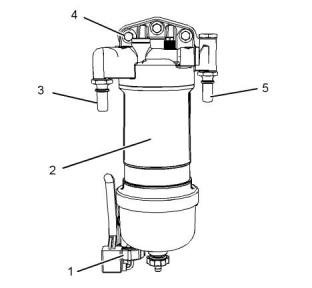
![]()
![]()
UENR0675
9
Specifications Section
i04084390
Fuel Manifold (Rail)
Refer to Operation and Maintenance Manual,
“General Hazard Information and High Pressure Fuel
Lines” before adjustments and repairs are performed.
NOTICE
Refer to Systems Operation, Testing and Adjust-
ing, “Cleanliness of Fuel System Components”
for detailed information on the standards of clean-
liness that must be observed during ALL work on
the fuel system.
Illustration 13
g01866794
Typical example
(A) Diameter of the lifter body....21.938 to 21.963 mm
(0.86370 to 0.86468 inch)
Bore diameter in the cylinder block
.........22.000 to 22.032 mm (0.86614 to 0.86740 inch)
Clearance
Clearance of the lifter..............0.037 to 0.094 mm
(0.00146 to 0.00370 inch)
i03519944
Rocker Shaft
Illustration 12
g02293653
Typical example
(1) Tighten the bolts to the following torque......22 N·m
(16 lb ft)
(2) Tighten the bolts to the following torque......10 N·m
(89 lb in)
(3) Tighten the fuel pressure relief valve to the
following torque...................................30 N·m (22 lb ft)
Note: The fuel pressure relief valve (3) should be
tightened an additional 24 degrees.
i03537811
Lifter Group
This document is printed from SPI². Not for RESALE
![]()
![]()
![]()
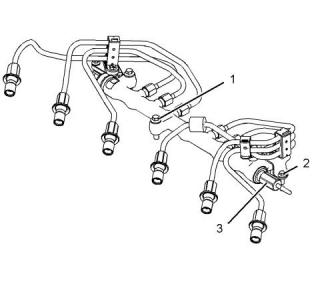
![]()
![]()

![]()
![]()
10
UENR0675
Specifications Section
(9) Spring
Illustration 15
g01850497
Tightening sequence
Tighten the fasteners in the sequence that is in
illustration 15 . Tighten the fasteners to the following
torque..................................................35 N·m (26 lb ft)
Illustration 14
g02113434
Typical example
(1) Tighten the threaded inserts to the following
torque..................................................30 N·m (22 lb ft)
(2) Retaining clip
(3) Spring
(4) Inlet rocker arm
Diameter of the rocker arm bore
......25.013 to 25.051 mm (0.9848 to 0.9863 inch)
(5) Exhaust rocker arm
Diameter of the rocker arm bore
......25.013 to 25.051 mm (0.9848 to 0.9863 inch)
Clearance
Maximum clearance of both the rocker arm
bores. ..............................0.089 mm (0.0035 inch)
The service limit for both rocker arm bores
..........................................0.17 mm (0.0067 inch)
(6) Guide
(7) Rocker shaft
Diameter of the rocker shaft
............................................24.962 to 24.987 mm
(0.98275 to 0.98374 inch)
(8) Retaining clip
This document is printed from SPI². Not for RESALE
![]()

![]()
![]()

![]()
![]()
UENR0675
11
Specifications Section
i03532881
Valve Mechanism Cover
Illustration 16
g01861234
Typical example
Tighten the bolts for the valve mechanism cover in
the sequence that is shown in illustration 16 . Torque
for the bolts..........................................9 N·m (80 lb in)
i03538600
Cylinder Head Valves
Illustration 17
g01927355
Typical example
(1) Exhaust valve spring
(2) Inlet valve spring
When the valve springs are replaced the valve
springs must be replaced in pairs.
This document is printed from SPI². Not for RESALE
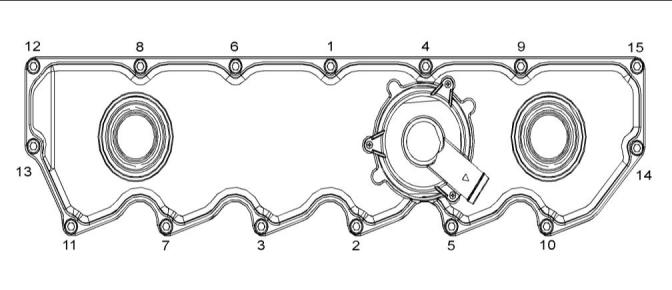
![]()
![]()
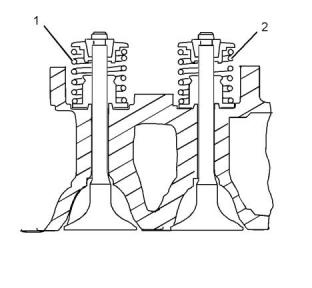
![]()
![]()
12
UENR0675
Specifications Section
Refer to table 1 and table 2 for information on the
length of the valve spring and the load of the valve
spring.
Clearance
Maximum clearance of the exhaust valve stem
Table 1
......................................0.075 mm (0.00295 inch)
The service limit for the exhaust valve stem
........................................0.10 mm (0.00394 inch)
The load for the inlet valve
spring
The length of the inlet valve
spring
161.5 to 178.5 N
(36.30682 to 40.12859 lb)
31.5 mm (1.2402 inch)
(5) Length of valve
Inlet valve.............................109.82 to 110.27 mm
(4.32361 to 4.34133 inch)
337.9 to 373.5 N
(75.96330 to 83.96654 lb)
21.5 mm (0.84646 inch)
Exhaust valve.................. 109.853 to 110.303 mm
(4.32491 to 4.34263 inch)
Note: The free length for the inlet valve spring is
40.65 mm (1.60039 inch).
(6) Valve head
Table 2
Diameter of inlet valve head ...................... 35 mm
(1.37795 inch)
The load for the exhaust valve
spring
The length of the exhaust valve
spring
Diameter of exhaust valve head ................ 33 mm
(1.2992 inch)
285 to 315 N
(64.07085 to 70.81515 lb)
31.5 mm (1.2402 inch)
408.5 to 451.5 N
(91.83488 to 101.50172 lb)
22.3 mm (0.87795 inch)
i04314230
Cylinder Head
Note: The free length for the exhaust valve spring is
52.73 mm (2.07598 inch).
Illustration 18
g01927357
Typical example
(3) Valve face angle
Inlet .....................................................30 degrees
Exhaust ..............................................45 degrees
(4) Valve stem diameter
Illustration 19
g01852017
Inlet....6.970 to 6.985 mm (0.2744 to 0.2750 inch)
Exhaust...................................6.945 to 6.960 mm
(0.2734 to 0.2740 inch)
Typical example
Lubricate the threads and the underside of the head
bolts with clean engine oil.
Clearance
Tighten the bolts in the sequence that is shown in
illustration 19 . Torque for the bolts............50 N·m
(37 lb ft)
Tighten the bolts again to the following torque.
...................................................100N·m (74 lb ft)
Maximum clearance of the inlet valve stem
..........................................0.05 mm (0.0020 inch)
The service limit for the inlet valve stem
..........................................0.08 mm (0.0031 inch)
This document is printed from SPI². Not for RESALE
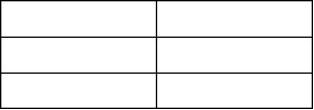
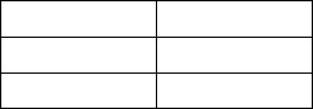
![]()
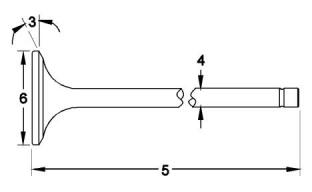
![]()
![]()
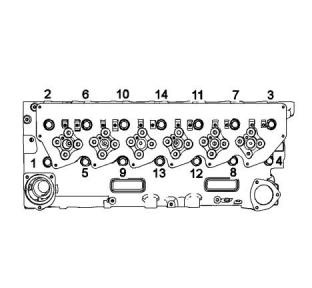
![]()
![]()
UENR0675
13
Specifications Section
Tighten the head bolts to the additional amount.
..........................................................225 degrees
Minimum thickness of cylinder head ...........150.8 mm
(5.93700 inch)
Illustration 20
g01854993
Typical example
Illustration 21
g02328933
Typical example
Note: The maximum distortion of the cylinder head is
given in table 3 .
(D) Valve guide height from the top of the valve guide
to the valve spring seat...................10.75 to 11.25 mm
(0.42323 to 0.44291 inch)
Table 3
Maximum Permissible
Dimension
Distortion
(E) Outside diameter of the valve guides
......... 11.029 to 11.040 mm (0.43421 to 0.43464 inch)
Width (A)
Length (B)
0.03 mm (0.0012 inch)
0.05 mm (0.0020 inch)
0.05 mm (0.020 inch)
(F) Length of the valve guides.......43.75 to 44.25 mm
(1.72244 to 1.74212 inch)
Diagonal Line (C)
(G) Internal diameter of the valve guides
.............7.007 to 7.020 mm (0.27587 to 0.27638 inch)
(H) Valve depths
Inlet....0.905 to 1.163 mm (0.0356 to 0.0458 inch)
The service limit for the depth of the inlet valve
.......................................... 1.41 mm (0.0555 inch)
Exhaust...................................0.876 to 1.131 mm
(0.0345 to 0.0445 inch)
The service limit for the exhaust valve depth
.......................................... 1.38 mm (0.0543 inch)
This document is printed from SPI². Not for RESALE
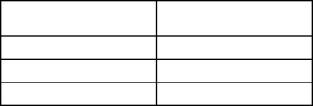
![]()
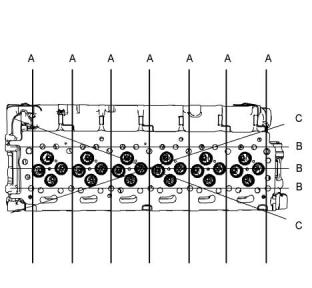
![]()
![]()
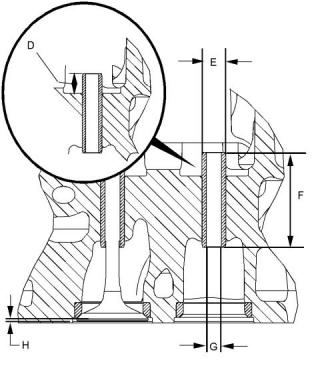
![]()
![]()
14
UENR0675
Specifications Section
(L) Seat surface finish .........................Ra 0.8 microns
(M) Concentricity of valve seat to valve guide parent
bore Maximum Total Indicated Reading (TIR)
...............................................0.08 mm (0.00315 inch)
i05365854
Turbocharger
(Series Turbochargers)
Note: For the correct procedure to install the
turbochargers, refer to Disassembly and Assembly,
“Turbocharger - Install”.
Illustration 22
g02474819
Typical example
(J) Diameter of the parent bore in the cylinder head
......... 11.000 to 11.022 mm (0.43307 to 0.43394 inch)
(K) Seat angle
Inlet .............................................. 119.15 degrees
Exhaust .........................................89.15 degrees
Illustration 24
g03097997
Typical example
(1) Actuator
The test pressure for the wastegate actuator
...............................................................60 kPa (9 psi)
The movement for the rod actuator ....................1 mm
(0.0394 inch)
(2) Tighten the studs to the following torque.
............................................................18 N·m (13 lb ft)
(3) Tighten the nuts to the following torque. .....44 N·m
(32 lb ft)
Illustration 23
g02475018
Typical example
This document is printed from SPI². Not for RESALE
![]()
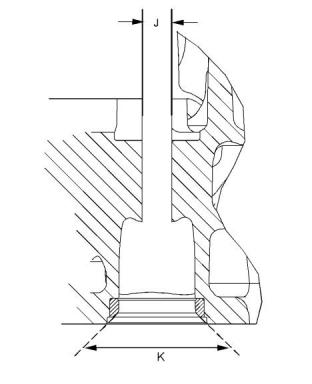
![]()
![]()

![]()
![]()

![]()
![]()
UENR0675
15
Specifications Section
Illustration 25
g03098036
Illustration 27
g02352719
Typical example
Tightening sequence for the nuts that secure the
turbocharger to the bracket
(4) (6) Tighten the studs to the following torque.
............................................................18 N·m (13 lb ft)
(5) (7) Tighten the nuts to the following torque.
............................................................44 N·m (32 lb ft)
Illustration 26
g03396277
Tightening sequence for the nuts that secure the
bracket to the cylinder block
This document is printed from SPI². Not for RESALE
![]()
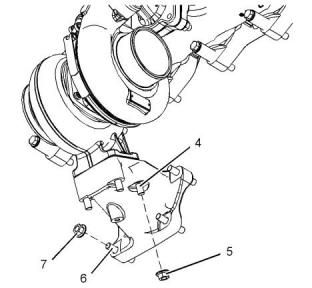
![]()
![]()
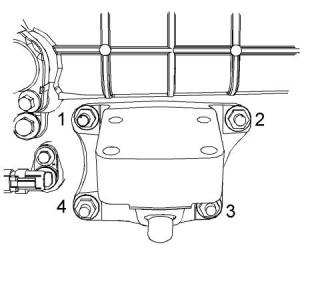
![]()
![]()
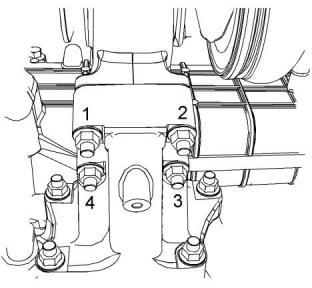
![]()
![]()
16
UENR0675
Specifications Section
Illustration 28
g03098058
Typical example
(8) Tighten the bolt to the following torque. ......15 N·m
(11 lb ft)
(9) Tighten the bolts to the following torque........9 N·m
(80 lb in)
(10) (11) (17) Tighten the bolt to the following torque.
............................................................18 N·m (13 lb ft)
(12) (14) (15) (16) Tighten the bolts to the following
torque..................................................22 N·m (16 lb ft)
(13) Tighten the bolt to the following torque. ....33 N·m
(24 lb ft)
This document is printed from SPI². Not for RESALE

![]()
![]()
UENR0675
17
Specifications Section
Illustration 29
g03120317
i04928651
Typical example
(18) Tighten the band clamps for the turbochargers to
the following torque..........................12 N·m (106 lb in)
Turbocharger
(Single Turbocharger)
(19) Tighten the band clamps for the ducts to the
following torque....................................6 N·m (53 lb in)
Illustration 30
g03120696
Typical example
(20) Tighten the band clamps for the turbochargers to
the following torque..........................12 N·m (106 lb in)
This document is printed from SPI². Not for RESALE
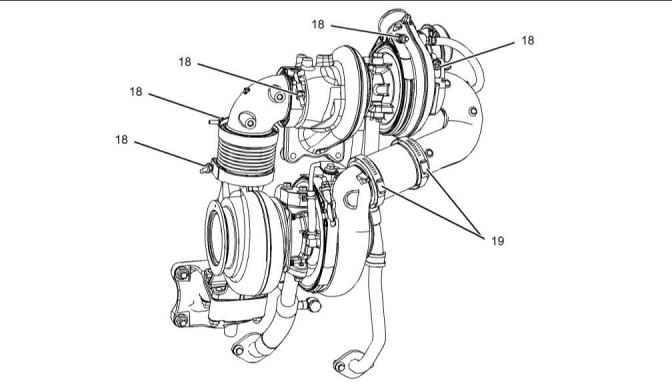
![]()
![]()
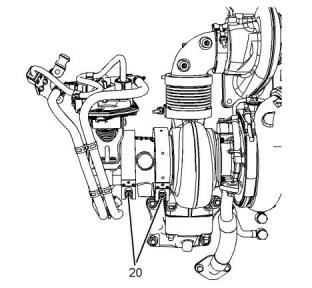
![]()
![]()
18
UENR0675
Specifications Section
Illustration 32
g03097926
Typical example
(8) Tighten the bolts to the following torque........9 N·m
(80 lb in)
(9) Tighten the bolt to the following torque. ......33 N·m
(24 lb ft)
Illustration 31
g03097898
Typical example
(10) Tighten the bolt to the following torque. ....22 N·m
(16 lb ft)
(1) Tighten the studs to the following torque.
............................................................18 N·m (13 lb ft)
(2) Tighten the nuts to the following torque. .....44 N·m
(32 lb ft)
i05380879
Injector (Diesel Exhaust Fluid)
(3) Tighten the bolt to the following torque. ......15 N·m
(11 lb ft)
(4) Tighten the studs to the following torque.
............................................................18 N·m (13 lb ft)
Table 4
Required Tools
(5) Tighten the nuts to the following torque. .....44 N·m
(32 lb ft)
Tool
Part Number
Part Description
Qty
Bostik Pure Nickel
Anti-Seize Compound
(6) Actuator
A
-
1
The test pressure for the wastegate actuator
...............................................................60 kPa (9 psi)
The movement for the rod actuator .................... 1 mm
(0.0394 inch)
(7) Tighten the band clamps to the following torque.
.........................................................12 N·m (106 lb in)
This document is printed from SPI². Not for RESALE

![]()
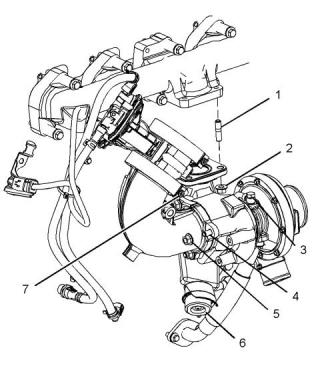
![]()
![]()
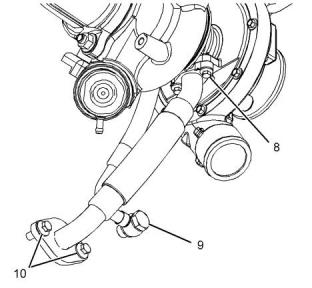
![]()
![]()
UENR0675
19
Specifications Section
Illustration 33
g03404738
Typical example
(1) Injector (Diesel Exhaust Fluid)
(2) Stud
(3) Washer
Lightly lubricate the thread of the studs (2) and nuts
(4) with Tooling (A) before installation.
(2) Tighten the studs to the following torque.......5 N·m
(44 lb in)
(4) Tighten the nuts to an initial torque. ..............5 N·m
(44 lb in)
(4) Tighten the nuts to a final torque...................5 N·m
(44 lb in)
Tighten the nuts to the additional amount. ..............90
degrees
This document is printed from SPI². Not for RESALE
![]()

![]()
![]()
20
UENR0675
Specifications Section
i05380938
Manifold (Diesel Exhaust Fluid)
Illustration 34
g03404759
Typical example
(1) Tighten the screws in the tightening sequence as
shown in illustration 34 to an initial torque.........5 N·m
(44 lb in)
(1) Tighten the screws in the tightening sequence as
shown in illustration 34 to a final torque.............5 N·m
(44 lb in)
i05380903
Diesel Exhaust Fluid Tank
Illustration 35
g03404743
Typical example
This document is printed from SPI². Not for RESALE
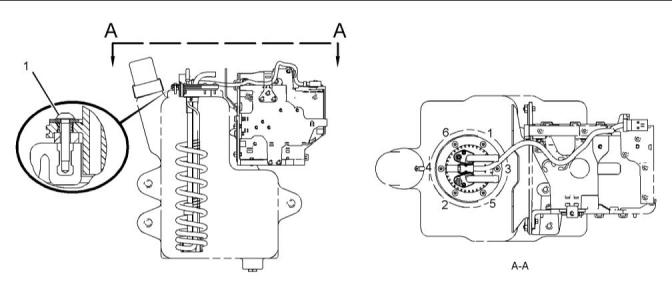
![]()
![]()
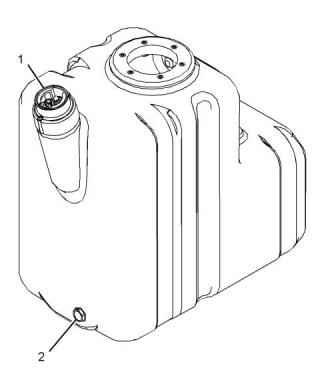
![]()
![]()
UENR0675
21
Specifications Section
(1) Tighten the cap adapter or hose adapter to the
following torque...................................15 N·m (11 lb ft)
Tighten the self-taping screws to the following torque.
..........................................................2.8 N·m (25 lb in)
(2) Tighten the plug to the following torque. .....11 N·m
(97 lb in)
Note: The Original Equipment Manufacturer (OEM)
may supply the Diesel Exhaust Fluid (DEF) tank.
Refer to the OEM for more information if the DEF tank
has been supplied by the OEM.
i05380925
Diesel Exhaust Fluid Pump
Illustration 37
g01946893
Typical example
(1) Tighten the bolts to the following torque......22 N·m
(16 lb ft)
Illustration 36
g03404752
Typical example
(1) Tighten the bolts to the following torque......19 N·m
(14 lb ft)
Note: The maximum wrench speed is 60 rpm.
i04928588
Exhaust Gas Valve (NRS)
This document is printed from SPI². Not for RESALE
![]()
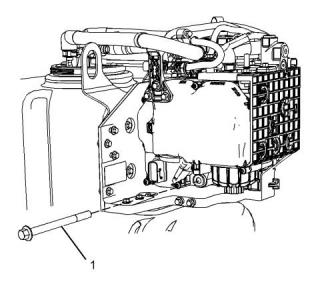
![]()
![]()
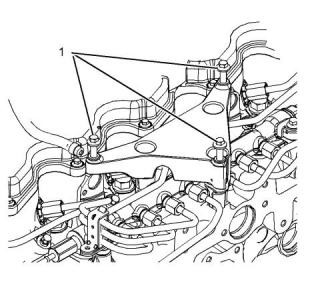
![]()
![]()
22
UENR0675
Specifications Section
Illustration 38
g02295533
Typical example
(2) Tighten the bolts to the following torque......18 N·m
(13 lb ft)
(3) Tighten the bolts to the following torque......22 N·m
(16 lb ft)
(4) Tighten the clamps to the following torque.
...........................................................11 N·m (97 lb in)
(5) Tighten the bolt to the following torque. ......18 N·m
(13 lb ft)
Illustration 39
g03097576
Typical example
(6) Tighten the bolt to the following torque. ......15 N·m
(11 lb ft)
(7) (8) Tighten the fasteners to the following torque.
............................................................18 N·m (13 lb ft)
This document is printed from SPI². Not for RESALE
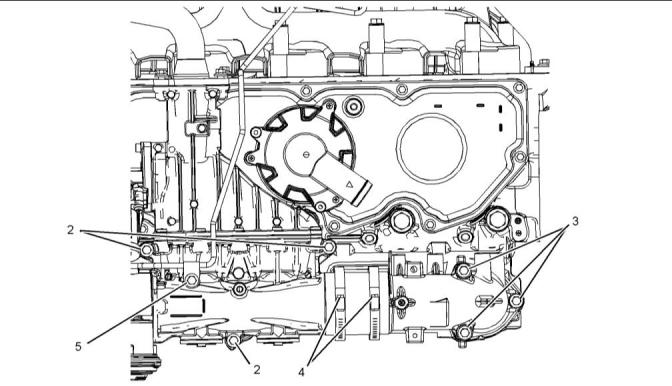
![]()
![]()

![]()
![]()
UENR0675
23
Specifications Section
i04928620
Exhaust Cooler (NRS)
Note: When the pipes for the exhaust cooler are
removed or installed, care must be taken so that the
pipes are not bent or damaged.
Illustration 40
g02295833
Typical example
(1) (2) Tighten the setscrews to the following torque.
............................................................22 N·m (16 lb ft)
This document is printed from SPI². Not for RESALE

![]()
![]()
24
UENR0675
Specifications Section
Illustration 41
g02295755
Typical example
(3) (6) (7) (9) Tighten the setscrews to the following
torque..................................................22 N·m (16 lb ft)
(4) Tighten the setscrews to, the following torque.
............................................................18 N·m (13 lb ft)
(5) (8) Tighten the setscrews to the following torque.
............................................................44 N·m (32 lb ft)
This document is printed from SPI². Not for RESALE
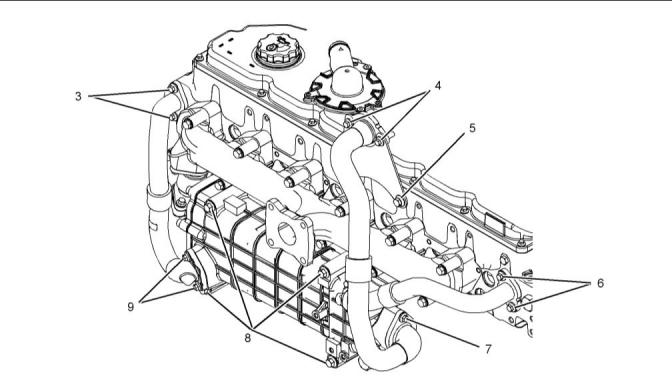
![]()
![]()
UENR0675
25
Specifications Section
i04364975
Exhaust Manifold
Illustration 42
g02330776
Typical example
Tighten the exhaust manifold bolts in the sequence
that is shown in illustration 42 to the following torque.
............................................................44 N·m (32 lb ft)
To measure the flatness of the exhaust manifold,
follow step 1 to step 4.
1. Remove all bolts and spacers from the exhaust
manifold.
2. Install two spacers and bolts into holes eleven and
twelve of port one of the exhaust manifold.
3. Tighten the bolts to a torque of 44 N·m (32 lb ft).
4. Use a suitable feeler gauge to measure the gap
that is between port six (holes nine and ten) of the
exhaust manifold and the cylinder head.
The maximum amount that the gap should be is
.................................................1.4 mm (0.05512 inch)
For the correct procedures to remove and install the
exhaust manifold, refer to Disassembly and
Assembly.
This document is printed from SPI². Not for RESALE

![]()
![]()
26
UENR0675
Specifications Section
i05365841
Flexible Exhaust Pipe
Illustration 43
g03396256
i05452413
Typical example
(1) Tighten the clamp to the following torque.
............................................................55 N·m (41 lb ft)
Camshaft
(2) Tighten the clamp to the following torque.
............................................................35 N·m (26 lb ft)
(3) Tighten the clamp to the following torque.
.........................................................12 N·m (106 lb in)
Refer to Disassembly and Assembly for the correct
procedure to install the flexible exhaust pipe.
This document is printed from SPI². Not for RESALE
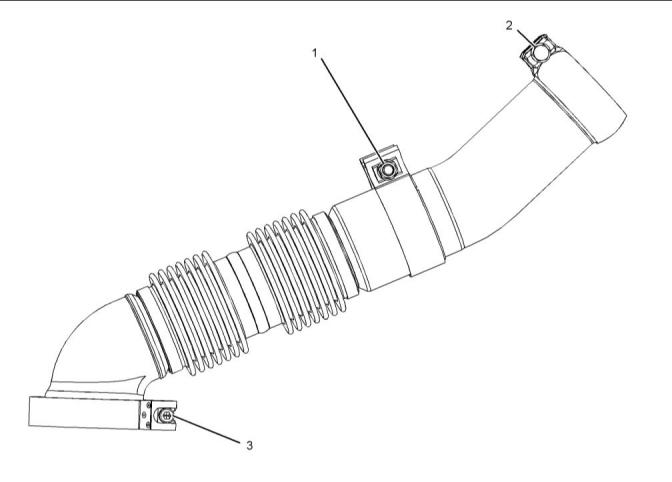
![]()
![]()
UENR0675
27
Specifications Section
Table 5
Camshaft Journals from
the Front End of the
Engine
Standard Diameter
1
Front
50.711 to 50.737 mm
(1.9965 to 1.9975 inch)
50.457 to 50.483 mm
(1.9865 to 1.9875 inch)
2
3
50.203 to 50.229 mm
(1.9765 to 1.9775 inch)
4
Rear
49.949 to 49.975 mm
(1.9665 to 1.9675 inch)
Maximum wear on the camshaft journals...... 0.05 mm
(0.0021 inch)
Check the camshaft lobes for visible damage. If a
new camshaft is installed, you must install new lifters.
Illustration 44
g01927854
Checking the end play of the camshaft
(1) End play of a camshaft.............0.106 to 0.558 mm
(0.00417 to 0.02197 inch)
Maximum permissible end play of a worn camshaft
.................................................0.62 mm (0.0244 inch)
Illustration 46
g02474757
Typical example
(4) Camshaft thrust washer
Outer diameter (X) ..............72.949 to 73.000 mm
(2.872 to 2.874 inch)
Thickness (Y) ......................... 5.486 to 5.537 mm
(0.21598 to 0.21799 inch)
Illustration 45
g03442257
Typical example
i03530782
Camshaft Bearings
(2) Bolt
Torque for the 8.8 graded bolt......95 N·m (70 lb ft)
Torque for the 10.9 graded bolt................120 N·m
(89 lb ft)
(3) The diameters of the camshaft journals are given
in the following tables.
This document is printed from SPI². Not for RESALE
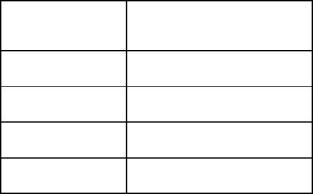
![]()

![]()
![]()
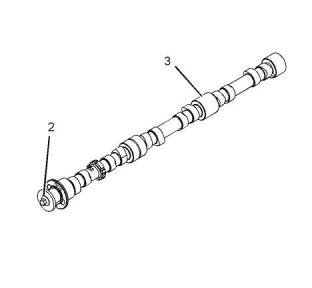
![]()
![]()
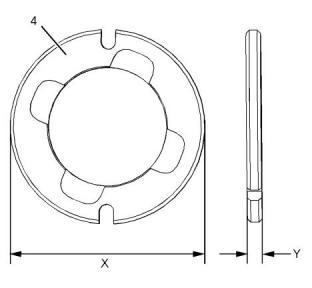
![]()
![]()
28
UENR0675
Specifications Section
Torque for the engine oil filter....12 N·m (106 lb in)
(3) Engine oil sampling valve
Torque for the engine oil sampling valve (if
equipped)..................................12 N·m (106 lb in)
Torque for the plug (if equipped)......12 N·m (106 lb in)
(4) Setscrew
Torque for the setscrews that retain the oil filter
base .............................................22 N·m (16 lb ft)
i04916915
Engine Oil Cooler
Illustration 47
g01859293
Engine Oil Cooler with a Low
Mounted Filter Base
Typical example
(1) The diameter of the installed camshaft bearing
.............50.787 to 50.848 mm (1.9995 to 2.0019 inch)
i03551117
Engine Oil Filter Base
Illustration 49
g03084977
Typical example
Setscrews
Tighten the setscrews in the sequence that is in
illustration 49 to the following torque.........22 N·m
(16 lb ft)
Illustration 48
g01877935
Typical example
(1) Dust cap
(2) Engine oil filter
This document is printed from SPI². Not for RESALE
![]()

![]()
![]()
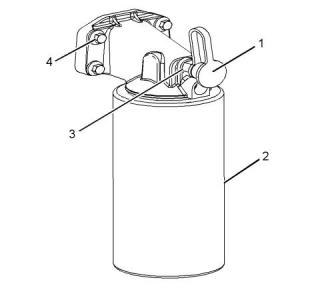
![]()
![]()

![]()
![]()
UENR0675
29
Specifications Section
Engine Oil Cooler with a High
Mounted Filter Base
Illustration 51
g00938064
(1) Clearance of the outer rotor to the body
.................0.050 to 0.330 mm (0.0020 to 0.0130 inch)
Illustration 50
g01854213
Typical example
Setscrews
Tighten the setscrews in the sequence that is in
illustration 50 to the following torque.........22 N·m
(16 lb ft)
Illustration 52
g00938061
i04363634
Checking the clearance
Engine Oil Pump
(2) Service limit of inner rotor to outer rotor
.................0.080 to 0.250 mm (0.0031 to 0.0098 inch)
Type ...............................Gear-driven differential rotor
Number of lobes
Inner rotor ........................................................... 6
Outer rotor ..........................................................7
Illustration 53
g00938799
Checking the end play
(3) End play of rotor assembly
Inner rotor................................0.050 to 0.180 mm
(0.0020 to 0.0071 inch)
This document is printed from SPI². Not for RESALE
![]()

![]()
![]()
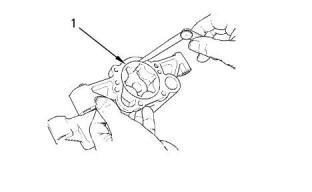
![]()
![]()

![]()
![]()
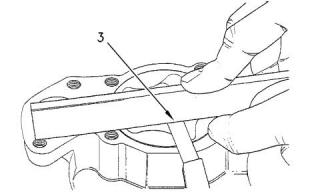
![]()
![]()
30
UENR0675
Specifications Section
Outer rotor............................... 0.050 to 0.180 mm
(0.0020 to 0.0071 inch)
Illustration 54
g02293754
Typical example
(4) Suction Pipe
(6) Bracket for the Suction Pipe
(5) (8) (9) (10) Tighten the bolts to the following
torque..................................................22 N·m (16 lb ft)
(7) Tighten the bolt to the following torque. ......44 N·m
(32 lb ft)
i03540441
Engine Oil Pressure
The minimum oil pressure at a maximum engine
speed of 2200 rpm and at normal operating
temperature is the following value.....315 kPa (45 psi)
This document is printed from SPI². Not for RESALE
![]()
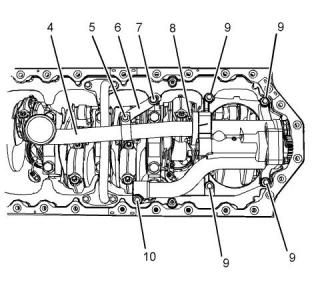
![]()
![]()
UENR0675
31
Specifications Section
i04129089
Engine Oil Pan
Illustration 55
g01856874
(X) Guide studs
(Y) Short fastener
Tighten the fasteners in the sequence that is shown in
illustration 55 . Torque for the fasteners ...........22 N·m
(16 lb ft)
This document is printed from SPI². Not for RESALE
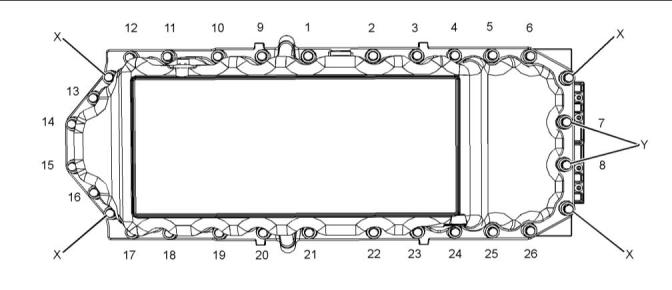
![]()
![]()
32
UENR0675
Specifications Section
Illustration 56
g01857014
Remove the guide studs. Install the fasteners (27),
(28), (29) and (30).
Tighten the fastener in the sequence that is shown in
illustration 56 . Torque for the fasteners ...........22 N·m
(16 lb ft)
Tighten the oil drain plug to the following torque.
............................................................34 N·m (25 lb ft)
Tighten the oil level switch (if equipped) to the
following torque...................................34 N·m (25 lb ft)
Refer to the Disassembly and Assembly, “Engine Oil
Pan” for the correct procedure to install the engine oil
pan.
The Cast Iron Oil Pan
This document is printed from SPI². Not for RESALE

![]()
![]()
![]()
UENR0675
33
Specifications Section
Illustration 57
g01397669
Tightening sequence
Tighten the fasteners in the sequence that is shown in
illustration 57 to the following torque. ..............22 N·m
(16 lb ft)
Tighten the oil drain plug to the following torque.
............................................................34 N·m (25 lb ft)
Tighten the oil level switch (if equipped) to the
following torque...................................34 N·m (25 lb ft)
i04085789
Crankcase Breather
Illustration 58
g02295333
Typical example
This document is printed from SPI². Not for RESALE
![]()
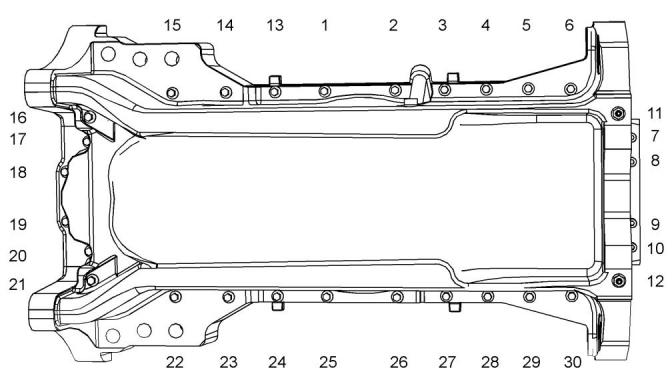
![]()
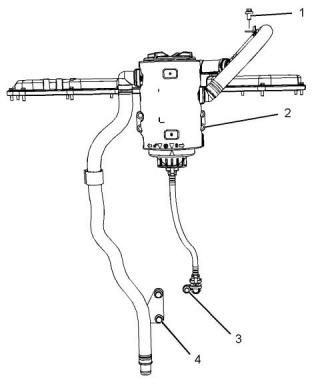
![]()
![]()
34
UENR0675
Specifications Section
(1) (2) (3) Tighten the setscrews to the following
torque..................................................22 N·m (16 lb ft)
(4) Tighten the setscrews to the following torque.
............................................................44 N·m (32 lb ft)
Note: If a hexagonal pillar spacer is required, install
the spacer to the engine oil cooler. Tighten the spacer
to a torque of 22 N·m (16 lb ft).
i03520180
Water Temperature Regulator
and Housing
Illustration 60
g01854133
(4) Water temperature regulator
Opening temperature..........................80° to 84°C
(151° to 176°F)
Maximum open length of 11 mm (0.43307 inch)
is achieved at the following temperature. .... 94° C
(201° F)
i03520301
Water Pump
Illustration 59
g01853873
Typical example
Water temperature regulator housing
(1) Torque for the bolts that fasten the housing to the
cylinder head ......................................22 N·m (16 lb ft)
(2) Torque for the vent plug........... 22 N·m (16.22 lb ft)
Illustration 61
g01850741
Tightening sequence
This document is printed from SPI². Not for RESALE
![]()
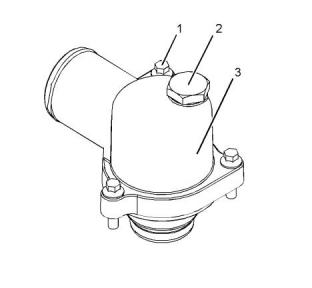
![]()
![]()
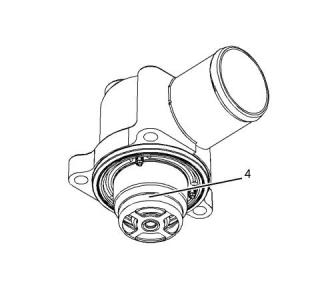
![]()
![]()

![]()
![]()
UENR0675
35
Specifications Section
Tighten the setscrews in the numerical sequence that
is shown in illustration 61 to the following torque.
............................................................22 N·m (16 lb ft)
(5) Main bearing cap bolts
Use the following procedure in order to install the
main bearing cap bolts:
1. Apply clean engine oil to the threads of the main
i04117792
bearing cap bolts.
Cylinder Block
2. Put the main bearing caps in the correct position
that is indicated by a number on the top of the main
bearing cap. Install the main bearing caps with the
locating tabs in correct alignment with the recess in
the cylinder block.
3. Evenly tighten the main bearing cap bolts.
Torque for the main bearing cap bolts. .............80 N·m
(59 lb ft)
4. After torquing the bolts for the main bearing caps,
the bolts must be rotated for an additional 90
degrees.
Note: Ensure that the crankshaft can rotate freely.
i04029133
Crankshaft
Illustration 62
g01855114
Cylinder block
(1) Cylinder block
(2) Cylinder bore....................105.000 to 105.025 mm
(4.1338 to 4.1348 inch)
(3) Camshaft bearings
Diameter of the bushing in the cylinder block for
the number 1 camshaft bearing
......55.563 to 55.593 mm (2.1875 to 2.1887 inch)
Diameter of the bore in the cylinder block for the
number 2 camshaft journal
......50.546 to 50.597 mm (1.9900 to 1.9920 inch)
Diameter of the bore in the cylinder block for the
number 3 camshaft journal
......50.292 to 50.343 mm (1.9800 to 1.9820 inch)
Diameter of the bore in the cylinder block for the
number 4 camshaft journal
Illustration 63
g01862538
Typical example
(1) Crankshaft gear
(2) Crankshaft
......50.038 to 50.089 mm (1.9700 to 1.9720 inch)
(3) Crankshaft thrust washers
(4) Main bearings
Maximum permissible temperature of the gear for
installation on the crankshaft..............180 °C (356 °F)
Bore in the cylinder block for the main bearings
......88.246 to 88.272 mm (3.4742 to 3.4753 inch)
This document is printed from SPI². Not for RESALE
![]()
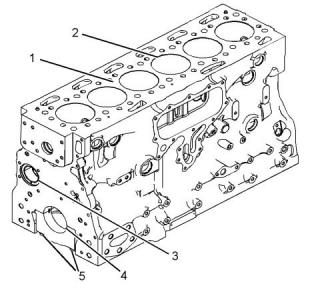
![]()
![]()
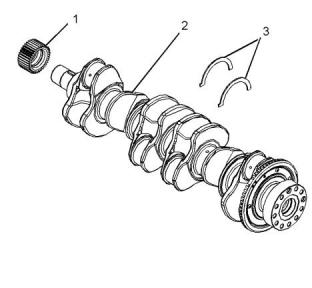
![]()
![]()
36
UENR0675
Specifications Section
The end play of a new crankshaft........ 0.1 to 0.41 mm
(0.00394 to 0.01614 inch)
Standard thickness of thrust washer
.....................2.69 to 2.75 mm (0.1059 to 0.1083 inch)
Oversize thickness of thrust washer
......................2.89 to 2.95 mm (0.1138 to 0.1161 inch)
Illustration 64
g01869273
i03520221
(4) Journal 1
(5) Journal 2
(6) Journal 3
(7) Journal 4
(8) Journal 5
(9) Journal 6
(10) Journal 7
Refer to Table 6 for the run out of the crankshaft
journals.
Crankshaft Seals
Table 6
Journal
Run Out of the Journals
(1)
Mounting
(2)
(3)
(4)
(5)
(6)
(7)
0.05 mm (0.0020 inch)
0.1 mm (0.0039 inch)
0.15 mm (0.0059 inch)
0.1 mm (0.0039 inch)
0.05 mm (0.0020 inch)
Mounting
You do not need to remove the engine oil pan in order
to install the oil seal.
Note: Some engines also have an oil seal that is
installed in the flywheel housing. Refer to
Specifications, “Flywheel Housing” for more
information.
Inspect the crankshaft for wear or for damage. For
more information regarding the servicing of the
crankshaft, contact the Global Technical Support
Center.
Refer to Specifications, “Connecting Rod Bearing
Journal” for more information on the connecting rod
bearing journals and connecting rod bearings.
Refer to Specifications, “Main Bearing Journal” for
information on the main bearing journals and for
information on the main bearings.
This document is printed from SPI². Not for RESALE
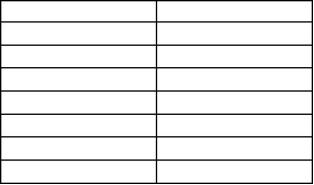
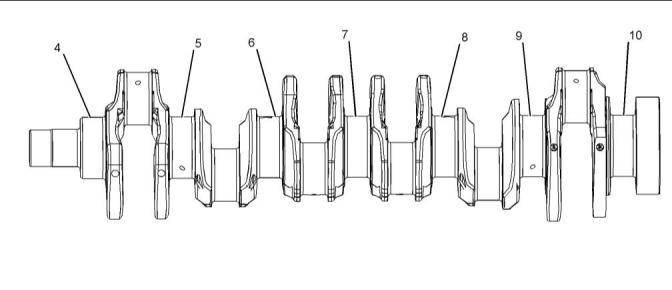
![]()
![]()
UENR0675
37
Specifications Section
The sequence for installationof the
rear oil seal
Illustration 66
g02282353
Typical example
(1) Tighten the setscrews for the adapter to the
following torque...................................40 N·m (30 lb ft)
The setscrews must be tightened through an angle of
120 degrees.
(2) Tighten the bolts for the damper and pulley to the
following torque.................................115 N·m (85 lb ft)
Illustration 65
g01863635
Typical example
(3) Vibration damper
(4) Crankshaft pulley
(5) Crankshaft adapter
(11) (12) Torque for the fasteners.......15 N·m (11 lb ft)
(1) (2) Torque for the fastener.............22 N·m (16 lb ft)
Loosen fastener (11) and (12) by one complete turn.
i05197127
Tighten the fasteners in the sequence that is in
illustration 65 . Torque for the fasteners ...........22 N·m
(16 lb ft)
Connecting Rod Bearing
Journal
The maximum out of concentricity between the
crankshaft flange and the outside diameter of the rear
seal for the crankshaft. ............0.4 mm (0.01575 inch)
The original size of the connecting rod bearing journal
on the crankshaft.......................71.970 to 71.990 mm
(2.83346 to 2.83425 inch)
i04067351
Vibration Damper and Pulley
Maximum permissible wear of a bearing journal on
the crankshaft when a new connecting rod is installed
.................................................0.04 mm (0.0016 inch)
Width of the connecting rod bearing journals on the
crankshaft..................................37.962 to 38.038 mm
(1.4946 to 1.4976 inch)
This document is printed from SPI². Not for RESALE
![]()
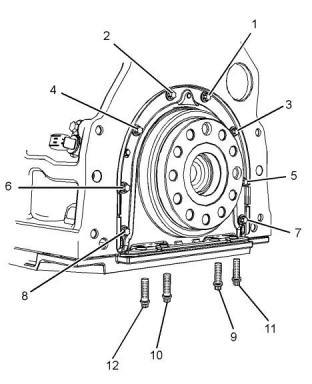
![]()
![]()
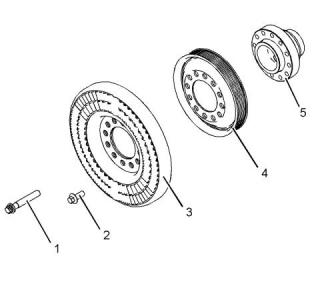
![]()
![]()
38
UENR0675
Specifications Section
Radius of the fillet of the connecting rod bearing
journals..........................................3.875 to 4.125 mm
(0.15256 to 0.16240 inch)
Clearance between the bearing shell and the main
bearing journals.............................0.036 to 0.094 mm
(0.00142 to 0.00370 inch)
Surface finish of connecting rod bearing journals
...........................................................Ra 0.25 microns
i04234795
Connecting Rod
Surface finish of radii ..........................Ra 0.4 microns
i05197134
Main Bearing Journal
The original size of the main bearing journal
.........83.980 to 84.000 mm (3.30629 to 3.30708 inch)
Maximum permissible wear of the main bearing
journals..................................0.040 mm (0.0016 inch)
Radius of the fillet of the main bearing journals
.............3.875 to 4.125 mm (0.15256 to 0.16240 inch)
Surface finish of bearing journals and crank pins
...........................................................Ra 0.25 microns
Surface finish of radii ..........................Ra 0.4 microns
Width of new main bearing journal where the thrust
washer is installed .....................35.235 to 35.165 mm
(1.3872 to 1.3844 inch)
Illustration 67
g01860862
Typical example
Width of new main bearing journal where the thrust
washer is not installed ...................35.25 to 35.15 mm
(1.38779 to 1.38386 inch)
(1) The bearing shell for the connecting rod
For the correct procedure to install the bearing shell
for the connecting rod, refer to Disassembly and
Assembly, “Pistons and Connecting Rods -
Assemble”.
The shell for the main bearings
The shells for the main bearings are available for
remachined journals which have the following
oversize dimensions.
Table 7
Thickness of Connecting Rod
Bearing at the Center
1.994 to 2.000 mm
(0.0785 to 0.0787 inch)
Oversize bearing shell ........0.25 mm (0.010 inch)
Oversize bearing shell ........0.50 mm (0.020 inch)
Oversize bearing shell ........0.76 mm (0.030 inch)
Thickness of Bearing Cap at
the Center
1.994 to 2.000 mm
(0.0785 to 0.0787 inch)
0.080 to 0.035 mm
(0.00315 to 0.00138 inch)
Bearing Clearance
Thickness at center of the shells of oversize bearing
shell 0.25 mm (0.010 inch) ...........2.226 to 2.232 mm
(0.08764 to 0.08787 inch)
Table 8
Oversize Connecting Rod Bearing
Thickness at center of the shells of oversize bearing
shell 0.50 mm (0.020 inch) ...........2.353 to 2.359 mm
(0.09264 to 0.09287 inch)
0.25 mm (0.010 inch)
0.51 mm (0.020 inch)
0.76 mm (0.030 inch)
Thickness at center of the shells of oversize bearing
shell 0.76 mm (0.030 inch) ...........2.480 to 2.486 mm
(0.09764 to 0.09787 inch)
Width of the main bearing shells ... 26.32 to 26.58 mm
(1.03622 to 1.04645 inch)
This document is printed from SPI². Not for RESALE
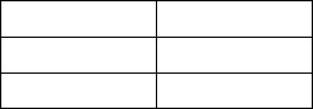

![]()

![]()
![]()
UENR0675
39
Specifications Section
Illustration 68
g01950657
Typical example
(U) Day code
(V) Code for the connecting rod
(X) Code for the Connecting rod cap
(Y) Year code
(Z) Code for the grade of connecting rod
Illustration 69
g01860878
Note: The day code is from the first day in the year.
For example, “001” will be the first day of the
appropriate year.
Typical example
(3) Diameter of the finished bore for the piston pin
.............39.738 to 39.723 mm (1.5645 to 1.5639 inch)
The mating surfaces of the connecting rod are
produced by hydraulically fracturing the forged
connecting rod. Ensure that the correct cap for the
connecting rod is installed with the correct connecting
rod. Ensure that the serial numbers for both
components match.
(4) Distance between the parent bores
...............219.05 to 219.1 mm (8.6240 to 8.6260 inch)
(5) Diameter for the finished bore for the connecting
rod bearing.................................76.025 to 76.038 mm
(2.99310 to 2.99362 inch)
(2) Torque of the setscrews for the connecting rod
............................................................40 N·m (30 lb ft)
The connecting rod is color coded. The color code is
a reference for the length of the connecting rod. Refer
to table 9 for the length of connecting rod.
Tighten the setscrews for the connecting rod for an
additional 120 degrees. The setscrews for the
connecting rod (2) must be replaced after this
procedure.
Table 9
Specificationsfor the Connecting Rod
Note: Always tighten the connecting rod cap to the
connecting rod, when the assembly is out of the
engine. Tighten the assembly to the following torque
20 N·m (14 lb ft).
Length Of The Connect-
Grade Letter Color Code
ing Rod
161.107 to 161.140 mm
(6.3428 to 6.3441 inch)
B
Blue
i04939374
Piston and Rings
This document is printed from SPI². Not for RESALE

![]()
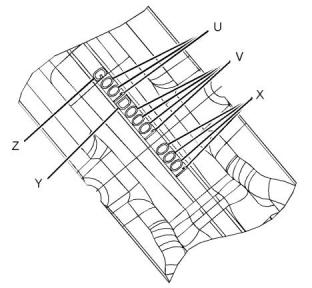
![]()
![]()
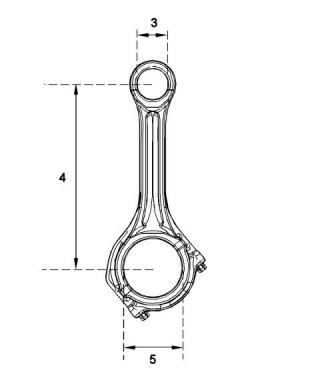
![]()
![]()
40
UENR0675
Specifications Section
(3) The oil control ring
Width of oil control ring................2.79 to 3.00 mm
(0.10984 to 0.11811 inch)
The clearance between a new oil control ring and
the groove in a new piston..........0.05 to 0.10 mm
(0.00197 to 0.00394 inch)
Ring gap......................................0.30 to 0.55 mm
(0.0118 to 0.0216 inch)
Note: When you install a new oil control ring, make
sure that the word “TOP” is facing the top of the
piston. New oil control rings have a red identification
mark. The identification mark must be on the left of
the ring end gap when the top piston ring is installed
on an upright piston. The oil control ring is a two-
piece ring that is spring loaded. A pin is used in order
to hold both ends of the spring of the oil control ring in
position. The ends of the spring of the oil control ring
must be installed opposite the end gap of the oil
control ring.
Illustration 70
g03120776
Typical example
Note: Ensure that the ring end gaps of the piston
rings are spaced 120 degrees from each other.
(1) Top compression ring
Piston
The shape of the top compression ring
...............................................................Keystone
Note: An arrow which is marked on the piston crown
must be toward the front of the engine.
Ring gap......................................0.25 to 0.35 mm
(0.00984 to 0.01378 inch)
Piston height above cylinder block.... 0.55 to 0.20 mm
(0.02165 to 0.00787 inch)
Note: When you install a new top compression ring,
make sure that the word “TOP” is facing the top of
the piston. New top piston rings have a black
identification mark. The identification mark must be
on the left of the ring end gap when the top piston ring
is installed on an upright piston.
Width of top groove in the piston ...................Tapered
Width of second groove in new piston
.....................2.56 to 2.58 mm (0.1008 to 0.1016 inch)
Width of third groove in new piston.... 3.05 to 3.07 mm
(0.12008 to 0.12087 inch)
(2) Intermediate compression ring
The shape of the intermediate compression ring
...............Internal bevel in the bottom edge with a
tapered face
Piston pin
Diameter of a new piston pin
......39.694 to 39.700 mm (1.5628 to 1.5630 inch)
Width of intermediate compression ring
............2.47 to 2.495 mm (0.0972 to 0.0982 inch)
i03520280
The clearance between a new intermediate
compression ring and the piston groove in a new
piston........................................0.065 to 0.110 mm
(0.00256 to 0.00433 inch)
Piston Cooling Jet
Ring gap......................................0.65 to 0.85 mm
(0.0256 to 0.0335 inch)
Note: When you install a new intermediate
compression ring, make sure that the word “TOP” is
facing the top of the piston. New intermediate rings
have a blue identification mark. The identification
mark must be on the left of the ring end gap when the
top piston ring is installed on an upright piston.
This document is printed from SPI². Not for RESALE
![]()
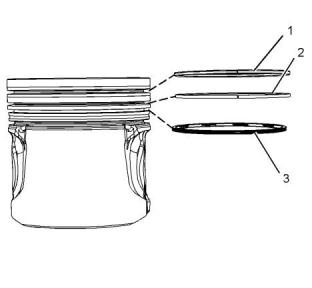
![]()
![]()
UENR0675
41
Specifications Section
3. The position of the rod (3) must be within
dimension (C). Dimension (C) is 10 mm
(0.39370 inch).
Note: Ensure that the rod (3) can not damage the
piston cooling jet when the alignment is checked. The
piston cooling jets can not be adjusted. If a piston
cooling jet is not in alignment the piston cooling jet
must be replaced.
i03907005
Accessory Drive
(SAE “B” )
Illustration 71
g01352576
(1) Installed piston cooling jets
The valve must move freely. Torque for the bolt
................................................................9 N·m (7 lb ft)
Piston Cooling Jet Alignment
Illustration 73
g02148374
Typical example
(1) Tighten allen head screws to the following torque.
............................................................22 N·m (16 lb ft)
Illustration 72
g01352578
(2) Piston cooling jet
(3) Rod
(4) Cylinder block
(2) Tighten the allen head screw to the following
torque..................................................78 N·m (58 lb ft)
Use the following procedure in order to check the
alignment of the piston cooling jet.
1. Insert rod (3) into the end of the piston cooling jet
(2). Rod (3) has a diameter of 1.70 mm
(0.067 inch). Rod (3) must protrude out of the top
of the cylinder block.
2. Dimension (A) is 58.5 mm (2.30315 inch) and
dimension (B) is 13.5 mm (0.53150 inch).
Dimension (A) and dimension (B) are tangential to
the cylinder bore (4).
This document is printed from SPI². Not for RESALE
![]()

![]()
![]()
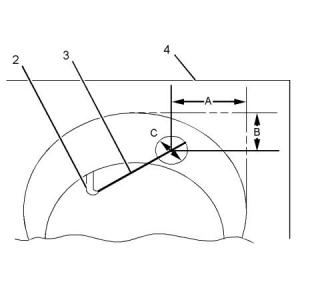
![]()
![]()
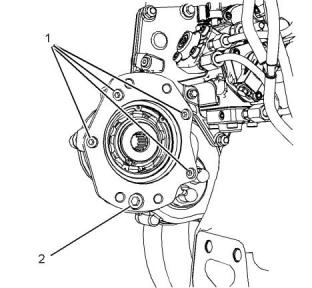
![]()
![]()

 English
English Espaol
Espaol Franais
Franais 阿拉伯
阿拉伯 中文
中文 Deutsch
Deutsch Italiano
Italiano Português
Português 日本
日本 韩国
韩国 български
български hrvatski
hrvatski esky
esky Dansk
Dansk Nederlands
Nederlands suomi
suomi Ελληνικ
Ελληνικ 印度
印度 norsk
norsk Polski
Polski Roman
Roman русский
русский Svenska
Svenska
